Maurice Tranchant
First issued: 1956
Reissues: 1998, 1999 (mousse gavroche), 2005
Catalogued 3B
Today's post is especially dedicated to my dear friend Hclub because she is an adoring fan of this beautiful design and she is going through a tough time right now. I know she'll enjoy this entry and hopefully it will put a big smile on her face.
We both felt in love with L'Art d'Ecrire when we saw Kelly Rutherford wearing it on Gossip Girl (season 1, episode 9), and since then we have shared a mutual love for it.
We both felt in love with L'Art d'Ecrire when we saw Kelly Rutherford wearing it on Gossip Girl (season 1, episode 9), and since then we have shared a mutual love for it.
L'Art d'Ecrire, The art of writing, refers us to calligraphy: The art of producing artistic, stylized, or elegant handwriting or lettering.
The word calligraphy is derived from the Greek words 'killi' and 'graphos', meaning "beautiful" and "writing".
The art of calligraphy as we know it today, finds its origins in cave paintings. As humans developed, the art of drawing pictures became quite highly developed and reached great heights under the direction of the Egyptians, who created the highly stylized hieroglyphics.
A few thousand years later, around 1000 BC, the Phoenicians went a step further and developed one of the first alphabets and writing systems. Being sea faring types, Phoenicians passed along their new skills to every seaport where they went. They influenced the Greeks who developed their own form of writing which by 850 BC the Romans adapted to suit the Latin language.
Latin was the lingua franca of the churches of Europe in the Middle Ages and the monks constituted the only literate members of society, they began to carefully scribe ancient texts into decorative books used by high-ranking church members and nobility members. Paper was expensive during the Middle Ages, so scribing monks developed a writing style that was narrower allowing more words to fit on a single line. This style came to be known as Gothic and lasted as a popular scribing technique throughout much of the Middle Ages.
By the mid-15th century, however, Johannes Gutenberg invented the printing press based upon the Gothic lettering of the monks. This new technique allowed faster printing of Bibles and threatened the métier of the monks. Although the use of the printing press spred worldwide, handwriting skills were still in high demand. As the arts bloomed during Europe's Renaissance, so did the art of calligraphy. The italic script was invented in Italy, and became popular throughout most of Europe.
The word calligraphy is derived from the Greek words 'killi' and 'graphos', meaning "beautiful" and "writing".
The art of calligraphy as we know it today, finds its origins in cave paintings. As humans developed, the art of drawing pictures became quite highly developed and reached great heights under the direction of the Egyptians, who created the highly stylized hieroglyphics.
A few thousand years later, around 1000 BC, the Phoenicians went a step further and developed one of the first alphabets and writing systems. Being sea faring types, Phoenicians passed along their new skills to every seaport where they went. They influenced the Greeks who developed their own form of writing which by 850 BC the Romans adapted to suit the Latin language.
Latin was the lingua franca of the churches of Europe in the Middle Ages and the monks constituted the only literate members of society, they began to carefully scribe ancient texts into decorative books used by high-ranking church members and nobility members. Paper was expensive during the Middle Ages, so scribing monks developed a writing style that was narrower allowing more words to fit on a single line. This style came to be known as Gothic and lasted as a popular scribing technique throughout much of the Middle Ages.
By the mid-15th century, however, Johannes Gutenberg invented the printing press based upon the Gothic lettering of the monks. This new technique allowed faster printing of Bibles and threatened the métier of the monks. Although the use of the printing press spred worldwide, handwriting skills were still in high demand. As the arts bloomed during Europe's Renaissance, so did the art of calligraphy. The italic script was invented in Italy, and became popular throughout most of Europe.
One of the most special things about today's scarf is to know more about Maurice Tranchant's source of inspiration for this design. We find out as soon as we take a look at the center of the scarf:
In fact, Tranchant virtually transferred into silk the treatise "L’Art d’écrire réduit à des démonstrations vraies et faciles...", included in the Diderot and D’Alembert Encyclopedia.
Denis Diderot (October 1713 – July 1784) was a French philosopher, art critic, and writer. He was a prominent persona during the Enlightenment and is best-known for serving as co-founder and chief editor of and contributor to the Encyclopédie.
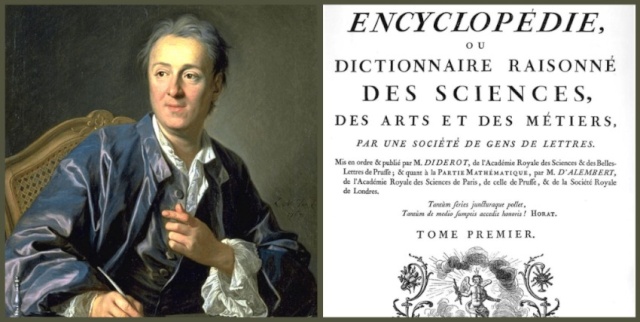
This stand alone volume of the Encyclopedia is a brief booklet of about 43 pages with 16 plates or illustrations, some of them are the exact source of Maurice Tranchant's inspiration:
Let's have a look at plates 2 y 3: "Materials and Correct Position to write for Men" and "Materials and Correct Position to write for Women". According to a survey conducted in 1877, 63% of the spouses were unable to sign their marriage certificate, it's no wonder then that a whole volume of the Encyclopedia was devoted to this subject.
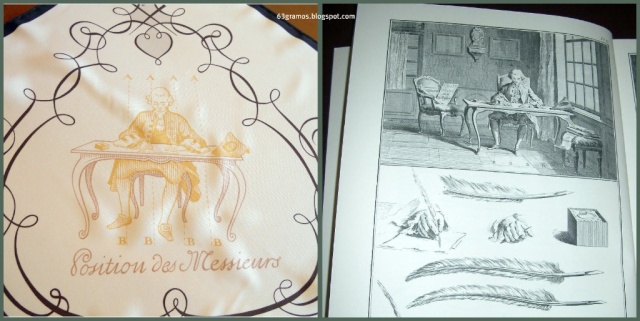
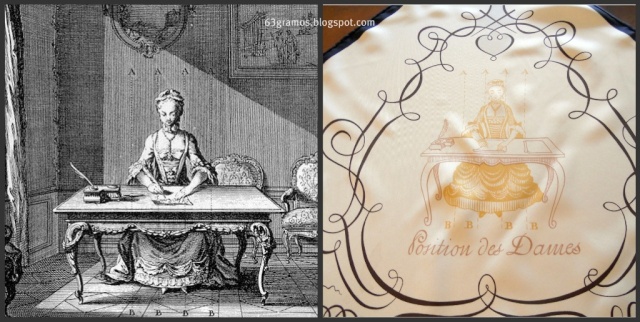
... And so on... From plates 4, 5 and 6 Tranchant got the illustrations about how to burnish and cut a quill, how to hold the quill different approaches and Traces and joints:
Let's have a look at plates 2 y 3: "Materials and Correct Position to write for Men" and "Materials and Correct Position to write for Women". According to a survey conducted in 1877, 63% of the spouses were unable to sign their marriage certificate, it's no wonder then that a whole volume of the Encyclopedia was devoted to this subject.


... And so on... From plates 4, 5 and 6 Tranchant got the illustrations about how to burnish and cut a quill, how to hold the quill different approaches and Traces and joints:
He also transferred the samples of lettering from plates 14, 15 and 16:
You can conclude that Maurice Tranchant was not a creative genius in designing this scarf as all the illustrations were copied from L'Encyclopedia. Anyway, L'Art d'Ecrire is one of the most beautiful scarves produced by Hermès and a very sought after design, it's a perfect gift for a graduation and a key piece of any classic wardrobe. I'm the lucky owner of two of them, a carré 90 and a 45 gavroche:
Other Tranchant's designs are:
Les Amorureux de Paris 1951
Ispahan 1966
Les Jardiniers du Roi 1967
Carrelages 1968
Grotte de Versailles 1969
Pavements 1970
Romantique 1973
Chanteclair 1974
Chanteclair II 1974
Imagerie 1974
**********************
I send a big hug to my dear friend Hclub wishing her lots of sunny days and beautiful things in her near future.

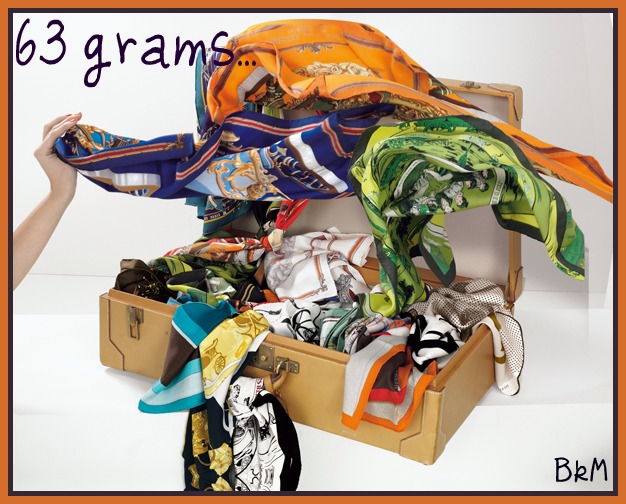
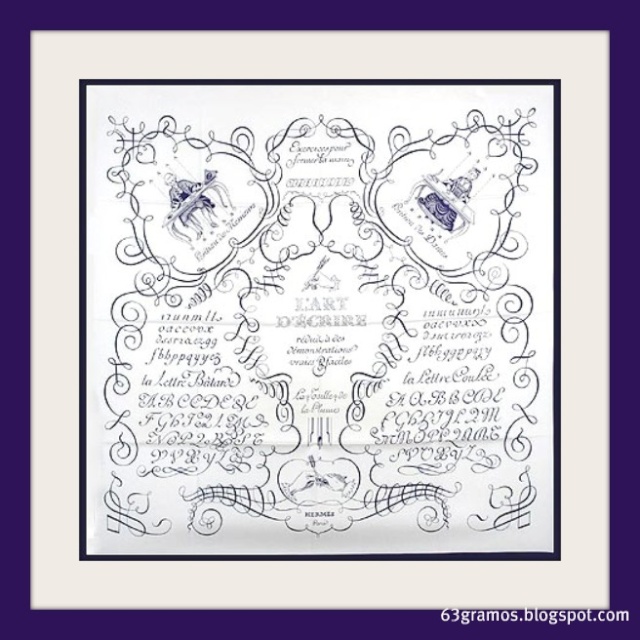
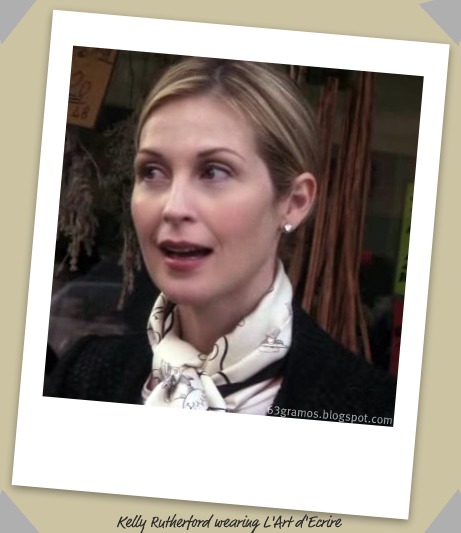

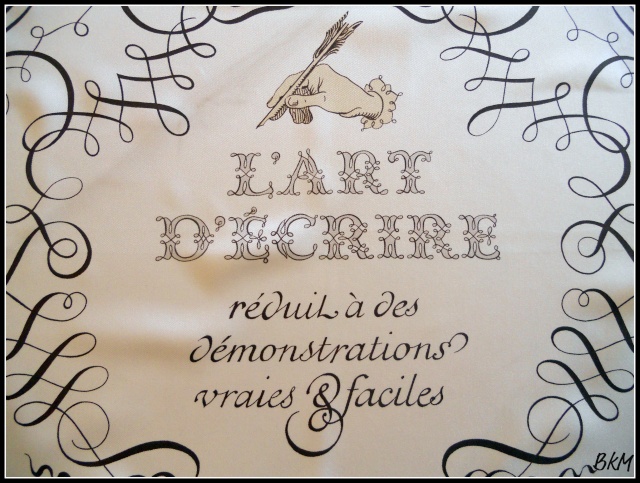

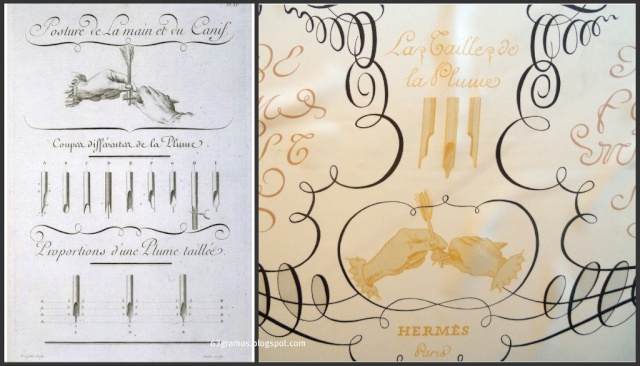
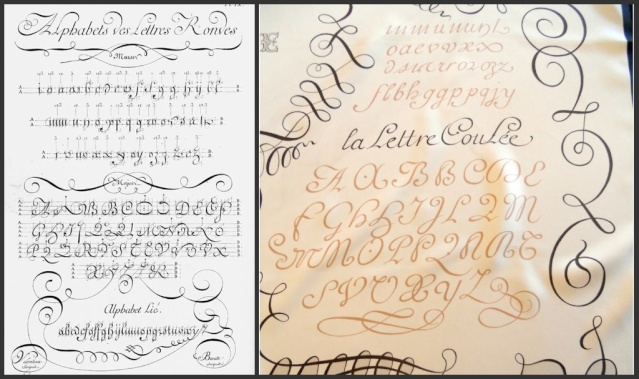


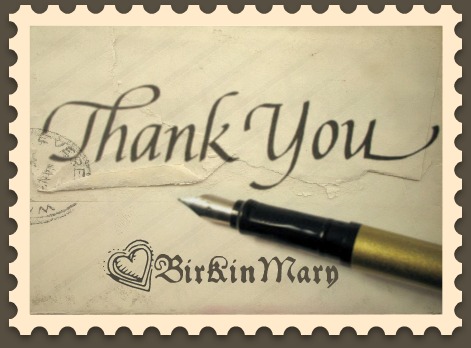
Bravo, Birkinmary! Another spectacular scarf profile. You are a superb researcher. How fascinating to know the inspiration for the design of L'Art d'Ecrire. Thank you so much for this blog. I just got my first L'Art d'Ecrire and I adore it!
ReplyDeletePauillac
This comment has been removed by the author.
ReplyDeleteYes, Pauillac. This research proved to be surprising for me too. We've got a scarf related to the Age of Enlightenment: Art, history, fashion, silk, style and Encyclopédie all together in a single carré!
ReplyDeleteThankyou for opening my eyes to the subtle charms of this beautiful design . I really like catching your enthusiasm , and shall look out for an example now . My mother was a gifted calligrapher and I always love admiring the graceful script
ReplyDeleteThank you Estrella for your lovely comment. Do you continue your mom's love of calligraphy?
ReplyDeleteCalligraphy is fascinating , but I'm not attracted to spending the hours my mother spent on the work .She did illuminated manuscripts , incredibly time consuming.
ReplyDeleteA lovely post on a lovely scarf!
ReplyDeleteTranchant took his drawing from Encyclopedia, but he disposed them so beautifully!
Jeanne, thank you for your words! ITA with you, Tranchant managed to design a piece of art.
ReplyDeleteI throroughly enjoyed this post, dear Birkinmary, your research and insights are second to none. It is such a beautiful scarf, and truly wonderful to know so much more about it, thank you xx
ReplyDeleteThank you MaiTai, I'm glad you enjoyed this review. I don't know if you already own a L'Art d'Ecrire but it'd go perfect with your classic, chic style.
ReplyDeleteI wish I'd own one, dear Birkinmary, maybe one day x
ReplyDeleteThank you for doing all of this research and sharing it with us! It definitely gives me a further appreciation and curiosity of my scarves. I don't have a L'Art d'Ecrire but like Maitai, maybe one day ;)
ReplyDeleteThank you for your comment, La Professionnelle, I'm glad you liked this profile, LdE works wonders for a classic wardrobe, the perfect "goes with everything" silk. We need find one for both you and MT ASAP!!!
ReplyDeleteBeautiful story.
ReplyDeleteI actually own the original 1956 scarf. One week after I bought it (for not that much!) from the vintage store La Marelle in Galerie Vivienne in Paris, Hermès came out with its reedition, LOL.
Hi Parigi! you are a lucky girl. That store sounds like vintage heaven.
ReplyDeleteBirkinmary, do go there next time you are in Paris. The selection is very high standard. And it is not far from the other vintage heaven, Didier Ludot.
ReplyDeleteI also got two carrés, both by Grygkar (one is "Panache et Fantaisie") from Troc en Stock on rue Clauzel. The place is a mad house. On week days, the fashionista home girls drop by and do more chatting than shopping. My two carrés cost nothing. The two together did not even clear the 80-euro mark. The eccentric owner was careful to show me the spots where the original colors had veered a bit (not noticeable at all). Of course it was ok with me, since many of those very early scarves do have fragile colors. For me, a little flaw like that is an endearing kind of signature of all artisan process.
Oh Parigi! Would you email me all these wonderful addresses? I'm in South America right now but I'm coming back home for Christmas and I'll probably have the chance of going to Paris for a couple of days, a little info like yours would be terrific!
ReplyDeleteDid you enjoyed my latest post here, do you like Turandot?
Yes I enjoyed the Turandot piece greatly.
ReplyDeleteThe vintage shops I like most in Paris are:
- Didier Ludot in the Palais Royal. Lots of 60's and 70's Chanel, Hermès accessories. And some museum-stanadrd haute couture gowns from all ages.
- Les 3 Marches de Catherine B, 1 et 3 rue Guisarde: Hermès and Chanel, but concentrated more on 90's stuff. I just happen to like the 60's and 70's artisanat much more.
- La Marelle, in the Galerie Vivienne, about a 4-mnute walk from Didiere Ludot.
- Doc et Troc, on 6 rue Clauzel. The wild card where I got the two Grygkar Hermès and my original bamboo-handled Gucci hobo. Total > 100 euro.
This article actually talks about quite a few of them, if not all.
http://tmagazine.blogs.nytimes.com/2011/07/27/lumiere-adventures-in-vintage/
I have a Turandot story. Well, it's not mine. It happened to a friend's brother.
ReplyDeleteHe saw the opera in Beijing, in the Forbidden City, directed by Zhang Yimou. Afterwards, the audience was being ushered out of the Forbidden City. This friend's brother tired a side door when no one was watching. It opened and he and a friend slipped in and toured the Forbidden City all alone in the middle of the night. He called his brother who was having dinner with me in Bangkok, and he said: "you'd never guess where I am." LOL.
We couldn't believe it ! Nearly an experience worth risking arrest for. Nearly.
This is such an elegant design, but I just wish that it wouldn't keep alluding Hclub's grasp!
ReplyDeleteThanks for the wonderful research on this design, as well as the tribute to your friend.
OMG, Parigi! that experience must have been the most exciting, frightening, thrilling one! your friend is brave indeed! can you just imagine being arrested in China? :O
ReplyDeleteJerrine, thank you for your comments. Every scarfie has her own elusive scarf, that's part of the fun. Pauillac and I have Geishas, Hclub has L'Art d'Ecrire... which one is yours?
ReplyDeleteVery interesting article, thank you. JFYI you mention at the bottom that "Ceres" is a Tranchant design. It is actually signed by Francoise Faconnet.
ReplyDeleteHi Anonymous, You are absolutely right, Ceres is a F.Faconnet design, thank you for reading my article with so much interest, I'll fix it right now.
Delete